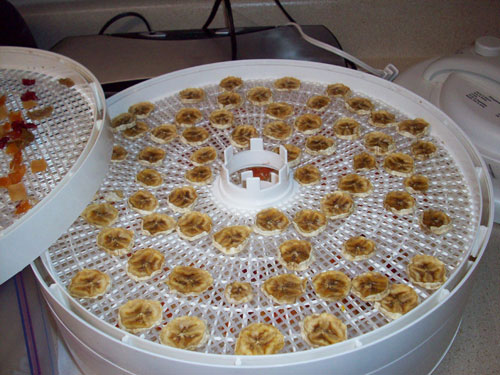Survival Dehydrating - Food Dehydrating for Long-Term Food Storage
To enhance long-term survival dehydrating foods is one of the best methods for food preservation without destroying the food's vitamins and minerals. As an alternative to canning or freeze-drying food, dehydration is easy, quick and produces food that does not take up much space when stored in basements or pantries.

Because dehydrated food stores well in airtight plastic bags or glass jars, the space required for canning jars or bulk storage (as in garbage cans) is not required. In addition, dried foods do not need refrigeration or even cooler storage areas, as eliminating the moisture content prevents growth of bacteria or other harmful microorganisms.
Important Information About Food Dehydration
Helpful advice regarding survival dehydrating techniques for food storage purposes includes:
- Dehydrate
only the freshest vegetable and fruits. Overripe produce is already
losing much of its moisture content and dehydrating such food could
result in tasteless, excessively chewy dried food.
- Try to
cut pieces of food into uniform sizes to enhance the drying process.
Vegetable and fruit slices will quickly dry if cut into 1/4- to 1/8-inch
slices.
- Wash grapes, herbs and berries before dehydrating to eliminate dust, insects or other unwanted debris.
- Browning
may be prevented if you steam or coat pale-colored food with ascorbic
acid or lemon juice. Blanching or steaming is also suggested when drying
vegetables so that enzymes causing toughening during the drying process
are inactivated.
- Successful dehydration of food involves removing water as quickly as possible so that the chance of spoilage is eliminated.
- Foods are sufficiently dehydrated when leathery and pliable, or brittle and hard.
- Dehydrated foods should be packed tightly but not so tight that the food is crushed.
Survival Dehydrating Methods
The easiest and most convenient method to use is to purchase a dehydrating machine already equipped with a fan, adjustable thermostat, timer, automatic shutoff and side- and top-mounted heating device. Home dehydrator prices range from $90 $200, depending on size.
Removable shelves or stackable trays allow placement of food into the dehydrator, which is then turned on to force hot, dry air into circulation around the food. In addition to dehydrating food, these devices can also be used to re-crisp soggy foods, sprout seeds, dry flowers and even as an incubator for hatching chicks. Humid conditions can slow down the drying process of an electric dehydrator, but not enough to compromise the usability of the food for survival purposes.
How to Make Fruit Leathers With an Electric Dehydrator
- Place pieces of fruit into a blender and process until smooth.
- Spread a 1/4-inch thick layer of the blended fruits onto a cellophane sheet.
- Put the sheet into a dehydrator and process at around 115 degrees Fahrenheit for four hours.
- Remove and let dry.
- Peel off the fruit leather, flip it, and dry out the other side for another two to three hours.
- Store in air-tight freezer baggies.
Dehydrating Foods Using the Solar Drying Method
Sun-drying is an economical technique that needs no electricity and provides a method to preserve food when electricity is not accessible. One drawback with using the sun to dry foods is that a climate conducive to such a process is necessary. Living in areas where the sun does not shine for at least three days in a row and the air isn't regularly dry and hot will inhibit the viability of sun-drying techniques.
Foods can be dehydrated using a combination of sun and air by laying food pieces on raised platforms protected by netting to prevent contamination by insects and animals. This type of hot-box dryer is the easiest to construct, but the drying process is directly affected by weather conditions, which may result in too-slow or too-quick dehydration of foods. When moisture is too slowly extracted from food, the potential for contamination exists, while drying food too quickly may cause extremely brittle, inedible food.
To avoid possible starvation when food resources have been substantially diminished or eliminated by a disaster, knowing survival dehydrating techniques will allow you to access a nutritious and clean supply of food capable of lasting for several years when properly stored.
Return from Survival Dehydrating to DIY Survival Food





New! Comments
Have your say about what you just read! Leave me a comment in the box below.